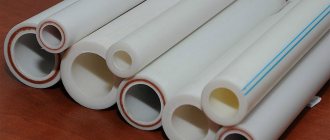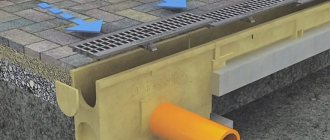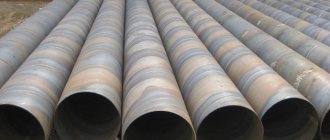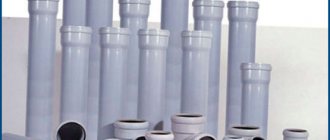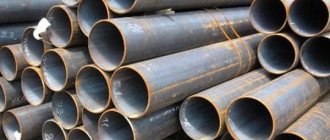DN - Nominal diameter.
Used as a characteristic of connected parts such as: pipeline fittings, fittings, connections for various types of pipelines.
Nominal diameter (rounded internal) does not mean the exact size in millimeters and is approximately equal to the value of the internal diameter of the connected pipeline in millimeters (Defined in GOST 28338-89, corresponds to ISO 6708-80).
The parameter was introduced to reduce the standard sizes of fittings, pipelines and various connecting parts; the concept of nominal diameter was adopted.
According to GOST 28338-89, it must be designated by the letters DN and a numerical value, which is selected from the standard series.
Previously the designation was used: Dy – Conditional diameter
All GOSTs mentioned in the text at the time of writing this article on 02/01/2018 are valid
The importance of choosing the required diameter
Which metal pipes to use for water supply in an apartment or house in order to eliminate unnecessary losses during the transportation of water flow must be determined at the stage of preparation for construction.
How does the internal diameter of steel pipes affect the operation of the pipeline:
- using a small value at high pressure in the network leads to noise in the pipeline, leakage is possible at the joints and installation of fittings;
- an exceeded size will require higher pressure in the system, unnecessary energy consumption;
- the cross-section of the pipeline depends on its length; long sections will require products of a larger cross-section;
- The size is affected by the number of connections, turns, branches, and points of consumption.
Insufficient internal passage of the water supply will lead to disruption of the uniform distribution of water flow. When a tap is open in one place, the pressure at other points will be low or there will be no pressure at all. This causes inconvenience and stops the operation of household appliances - washing machine, dishwasher, boiler.
A reduced cross-section of the pipeline leads to constant increased pressure in the system; it will work under strain, which leads to breakdowns and a decrease in its reliability. Correct preliminary calculations taking into account the laws of hydrodynamics will allow you to design an efficient water supply network and select the required sizes of pipes and shut-off plumbing fittings.
Calculation
How to calculate the optimal pipe size with your own hands when installing plumbing or heating?
Instructions for heating and water supply systems will differ markedly.
Heating
The key parameter here is the heat flow that the pipe can pass. It can be increased by increasing the internal diameter (which is unprofitable, since with its increase the price per linear meter of pipe increases nonlinearly) or coolant velocity .
The speed, however, is limited from above to a maximum value of 1.5 m/s: as it increases further, the hydraulic noise becomes difficult to bear. In practice, when calculating heating systems, a speed range of 0.4 - 0.6 m/s is used.
Fortunately, modern circulation pumps allow flexible adjustment of performance.
For the convenience of the reader, I will include in the article a table of the dependence of heat flow on the nominal diameter of the pipe.
| DN | Heat flow (kW) at coolant speed | ||
| 0.4 m/s | 0.5 m/s | 0.6 m/s | |
| 15 | 5,8 | 7,2 | 8,6 |
| 20 | 10,2 | 12,8 | 15,3 |
| 25 | 16 | 20 | 24 |
| 32 | 26,2 | 32,7 | 39,2 |
| 40 | 40,9 | 51,1 | 61,3 |
| 50 | 63,9 | 79,8 | 95,8 |
How to use this table? You just need to select the heat flow value that is as close as possible to yours and find the corresponding diameter in the left column.
How to calculate the heat flow in your heating system?
- For an autonomous circuit, when calculating bottling, the thermal load is taken equal to the rated power of the boiler;
- Individual sections of the circuit and connections to radiators are calculated based on the rated power of the devices;
- In the absence of technical documentation for them, the power can be roughly estimated at 200 watts per radiator section.
Thermal power of some heating devices.
Water supply
Accurately calculating the throughput of a steel pipe with a known diameter is extremely difficult, since, in addition to the pressure in the water supply system, it must take into account its hydraulic resistance.
And it, in turn, depends on:
- pipe length;
- number and angle of turns;
- shut-off and control valves;
- pipe wall roughness;
- its service life. Over time, steel pipes become overgrown with rust and lime, which increases their roughness and reduces clearance.
Typical condition of an old water pipe.
In practice, the owner of an apartment or private house just needs to remember a simple rule:
- When the length of the water supply line is up to five meters and the number of simultaneously used plumbing fixtures is no more than three, size DN 15 ;
- With a water pipe length of 5 - 30 meters and the number of simultaneously used plumbing fixtures up to five, the nominal size of the water pipe increases to DN 20 ;
- For a larger length and/or number of toilets and sinks, a DN 25 steel pipe or a plastic pipe equivalent in capacity is used.
Metal-plastic liner for the sink in my basement.
Symbols on diagrams
The concept of diameter for a pipeline includes several characteristics, these are:
- External Dн (international designation ID - Inner Diametr) is measured along the outer circumference.
- Internal (international designation OD - Outer Diametr) is determined by the wall thickness, this is the difference between the outer size and two wall thicknesses
- The conditional bore (Dу), also known as the nominal diameter, corresponds to the internal diameter, rounded to the nearest standard value. The value is regulated by GOST 28338-89.
The wall thickness is standardized. The permeability and strength of the pipe, as well as its weight, depend on it.
Nominal and nominal diameters
The nominal diameter DN is required when choosing fittings and other fittings, connecting different types of elements. This is the inner diameter rounded up. The parameter was adopted to unify the standard sizes of pipeline connecting elements. The value is regulated by GOST 28338-89. Previously it was called conditional passage.
The parameter characterizes the throughput capacity of the pipeline. The size is necessary when connecting pipes made of different materials; walls of different thicknesses make the external size irrelevant. By selecting elements according to conditional or nominal diameter, we ensure the same amount of flow along the entire length of the network.
How are pipes marked?
To make it clear what a pipe control is, you need to talk about the generally accepted marking of pipes according to GOST. That is, “DN” is the nominal diameter, and its value is indicated in digital terms. For example, if the nominal diameter of the pipeline is 150 mm, then such products are marked with DN 150.
However, we note that the actual internal cross-section of pipes with similar markings may be completely different. In particular, rolled pipes with an external and internal cross-section of 156/144 or 156/149 mm can be produced with this marking.
This discrepancy is due to the fact that GOST provides only two standard section sizes - 125 and 150 mm. Consequently, these passage values are rounded up to a “conditional” indicator.
Since pipe products of domestic and imported origin must be similar in size, the same standards for conventional dimensions are adopted abroad, and pipes are marked DN.
Division into classes depending on diameter
The relationship to the size class depends on the diameter, determined by GOST 10704-91. The classification is as follows:
- large-size – 530 – 720 and further up to 1420mm;
- medium - 114 - 140 and up to 530 mm;
- small - 10; 12; 14; 16; 18; 20 and up to 108 mm.
Small diameters are used for internal water supply in residential and other buildings where people are located. Medium-sized ones are intended for external municipal utility networks and process pipelines. Large-size pipelines are designed for laying oil and gas pipelines.
What determines the diameters of valves?
The use of valves of different diameters as shut-off valves is most often caused by the technical conditions for each specific type of pipeline and the conditions of the products transported through it. The diameters of the valves are determined by the internal diameter of the device cavity. This feature of marking and sizing is caused by the need to provide the simplest possible way for the transported flow to pass through the pipeline.
The developed state standards define the main types of shut-off valves. These types include:
- Flanged valves;
- Steel valves;
- Cast iron valves;
- Gate valve types;
- Wedge types of valves.
For each type of fittings, norms and standards have been developed that determine not only the internal diameter of the holes, but also the types of connections and the dimensions of the flange elements. The following standards are used for classification:
- GOST 3706-93 - standard for the production of flanged types of valves;
- GOST 9698-86 - defines the standard for two types of fittings for steel and cast iron valves;
- GOST 10738-76 - used to classify wedge-shaped types of shut-off valves;
- GOST R 55020-2012 - classifies gate structures.
Classification of water pipes
Historically, measurements were calculated in inches. This meaning differed in each state. It was conventionally equated to:
- the width of the index finger;
- the length of three barley grains from the middle of the spikelet;
- the ratio of the distance from the tip of the nose to the thumb of the outstretched hand of King Henry 1 of England.
As a result of the development of civilization and relationships between states, people realized that it was inconvenient to use such a value for full-fledged trade. For this reason, everyone switched to a common measuring system and distances began to be measured in meters. The value of the current meter was fixed in 1983 at the XVII General Conference on Weights and Measures. At this stage it is tied to the speed of light. Despite this, diameters in water pipes continue to be measured in inches. It is officially recognized that this unit is equivalent to 0.0254 meters, or 25.4 mm.
Wedge types of shut-off valves
The wedge type of the working body ensures simple and at the same time effective closing of the working passage. This property allows the valve to be widely used in pipelines for various purposes, from conventional water supply systems to systems for transporting aggressive substances.
Rubber-lined types of wedge valves are used in bodies made of cast iron, steel or special alloys. The connection can be either flanged or wafer; for devices with a rubberized wedge, the welding installation method is not used.
For installation, the following dimensions are used for the working passage of the cast iron body:
- 150 mm - 50, 65, 80, 100 mm;
- From 150 to 500 mm - 125, 150, 200, 250, 300, 350, 400 and 500 mm;
- Up to 1000 mm - 600 mm;
- For steel wedge valve bodies, the following working passage diameters are used:
- Up to 150 mm - 50, 65, 80, 100 mm;
- From 150 to 500 mm - 125, 150, 200, 250, 300, 350, 400 and 500 mm;
- Up to 1000 mm - 600 mm;
- Over 1000 mm - 1600 mm.
When using an electric drive, wedge valves mainly use a working passage diameter of up to 600 mm. Some manufacturers limit the series of wedge valves to a working passage diameter of 500 mm.
Main dimensions
Each water pipe has a diameter and other individual dimensions:
- internal distance between walls;
- the size of the required passage;
- nominal diameter;
- external thickness;
- wall thickness.
The throughput and profitability of the entire water supply system depends on these values. When designing, installing and repairing it, you must be especially careful to comply with these dimensions. A discrepancy of 1 mm at one connection can lead to failure of the entire structure.
Product Dimensions Tables
To facilitate the selection of products for a planned or already operating production line or communication system, tables of diameters of metal pipes and products made of other materials have been compiled.
It is not difficult to get acquainted with their full versions. Within the scope of the article, the product measurements used in them should be listed.
Each table may include a complete list of the above parameters, or some of them. For example, nominal diameter (in millimeters), thread diameter (in inches), outer diameter and wall thickness (both in millimeters).
Why is the exact size of the systems used determined?
The exact diameter value will allow you to calculate the planned volume of the substance to be transported through the pipeline. Knowledge of the characteristics of the parameters of various systems is important both on an industrial scale and at home.
The installation of a heating system or its repair in your home is carried out with preliminary calculations so that winter does not take you by surprise and all living rooms are heated efficiently and evenly. The recommendations and features described above will allow you to learn more about the parameters of the pipeline. If you have any doubts or difficulties, it is better to consult a specialist.
Steel
Steel pipe size chart
When installed with steel products, their selection is made according to the outer diameter of the water supply system pipe. According to the requirements of GOST 10704–91, they are divided into groups:
- large diameter - from 508 mm;
- medium – 114-530 mm;
- small – up to 114 mm.
In home plumbing, the most popular products are those with small sizes. Medium - in the city water supply. Large - for main oil and gas pipelines. The most popular products include:
- ½” - 12.7 mm;
- ¾” - 19.0 mm;
- 1” - 25.4 mm;
- 1½” - 38.1 mm.
Specialists who are involved in laying and repairing water pipes on a daily basis know these values by heart, while others look them up in tables.
Inches and millimeters
The ratio of sizes in inches and millimeters in the marking of water fittings does not follow a clear pattern. Alas, you cannot simply multiply the number of inches by 25.4: the result will be far from standard DU values.
But you can remember the table of their correspondence:
| DN (mm) | DN (inches) |
| 15 | 1/2 |
| 20 | 3/4 |
| 25 | 1 |
| 32 | 1 1/4 |
| 40 | 1 1/2 |
| 50 | 2 |
The size of this faucet is in inches.
How to check quality
Since the internal clearance can be different, you have to control the external dimensions and wall thickness. Thickness is more important. It must be measured at different points, at both ends of the pipe. Approximately this parameter can be tracked by the mass of a linear meter.
By the way, there can be considerable deviations in wall thickness. The standard allows deviations both upward and downward. If the diameter of steel pipes is no more than 40 mm, permitted deviations are up to 0.4 mm in the direction of increase and up to 0.5 mm in the direction of decrease. There are two categories of pipe production: regular and high precision. For products of increased precision, the deviation towards decreasing wall thickness is slightly less.
Permissible deviations for VGP
Examples of designations for pipes that are manufactured in accordance with this standard: pipe 20*2.8 GOST 3262-75. It should be read as a pipe with a standard diameter of 20 and a wall thickness of 2.8 mm.
From the table you can determine that this is a pipe of normal strength with an outer diameter of 26.8 mm. There you can also find the approximate mass of a meter depending on the thickness of the walls.
Pipes type
Type of Pipes - electric welded and seamless. They are designed for transporting liquids and gases. So this is exactly the type that can be used in our heating and water supply systems. The main characteristic of pipes type pipes is the internal diameter. There are two strength standards in this group, which determines wall thickness and operating pressure.
- Schedule 40 or standard. The designation may include st (as in the figure below). These are products with standard wall thickness.
- Schedule 80 or extra heavy. The designation is EX. This is a material for use in high pressure pipelines.
Difference in internal diameters of Pipes of different strength categories: standard and heavy
As you understand, with the same external size, the clearance will be different. Let's take a two-inch pipe as an example. It is designated as NPS=2″ internal diameter in different designs differs:
- standard (standard) schedule 40 - 2.067 inches (which is approximately equal to 5.25 cm);
- extra heavy schedule 80 - 1.939 inches (approximately 4.925 cm).
These categories standardize wall thickness and maximum operating pressure. The outer diameter remains constant, but the actual inner diameter changes with the wall thickness. That is, NPS=2″ describes the inside diameter, which will be about two inches, but will vary depending on the wall thickness. Here the situation is similar to our standards: there is a certain list of values to which actual parameters are rounded when labeling. Once again: if we are talking about a two-inch Pipe type pipe (the marking says NPS), you need to understand that we are talking about the internal diameter, but it will not be exactly two inches. It will be either a little more or a little less. Same with other sizes in inches.
Useful little things
Finally, let us give some useful advice to the owner of a house or apartment who is planning to install a plumbing or heating system with his own hands.
- It makes sense to use black steel only for heating. And this is provided that the heating system is not reset for the summer: the combination of dampness and access to air is contraindicated.
- Galvanizing is done exclusively on threads. The instructions are due to the fact that the zinc coating on welded joints burns out.
- To seal threaded connections, the easiest and cheapest way is to use flax with paint. Linen is cheap, but susceptible to rotting; paint completely solves this problem.
Winding the thread with flax and paint.
Type Tubes
The word Tubes refers to pipes that are marked by outer diameter. The internal one will depend on the wall thickness. Therefore, this standard also contains the concept gauge, which can be translated as gauge. It just indicates the wall thickness.
The same diameters of steel pipes do not mean the same weight
The marking is marked with ASTM. The numbers following the abbreviation describe the outer diameter. In this group, we may be interested in copper pipes.
Which pipe is considered small - medium - large?
Even in serious sources I have seen phrases like: “We take any pipe of average diameter and...”, but no one indicates what this average diameter is.
To figure it out, you should first understand what diameter you need to focus on: it can be internal or external. The first is important when calculating the transport capacity of water or gas, and the second is important for determining the ability to withstand mechanical loads.
External diameters:
- From 426 mm is considered large;
- 102-246 is called average;
- 5-102 is classified as small.
As for the internal diameter, it is better to look at the special table (see above).
How much does 1m of steel pipe weigh? Weight calculation
If there is no pipe table, then you can calculate the mass of 1 linear meter using the calculation formula on a regular calculator and find out how many kg are in a meter of pipe:
Calculation of the weight of stainless steel pipes: m = Pi*(d – s)*s*R/1000
m – theoretical mass of one linear meter of pipe (specific gravity) in kg,
Pi = 3.14 (constant value in our calculation),
d – outer diameter in mm,
s – wall thickness in mm,
R – specific gravity of steel in g/cubic meter. cm.
The weight of 1 m of VGP pipe in the assortment is calculated at a specific gravity of steel equal to 7.85 g/cm3. Galvanized steel pipe products are 3% heavier than non-galvanized steel. To automate the process of calculating pipes, you can use the online pipe calculator (round, VGP, seamless, electric-welded), presented in the section of the website “Rolled metal assortment”. In this pipe metal calculator, you can select the material from which the pipe is made for a more accurate calculation of weight.
Steel pipes, depending on their parameters and cross-sectional dimensions: diameter and wall thickness, have different areas of application:
• installation of heating systems, laying water communications, gas pipelines, installation of sewerage, water disposal and gas supply;
• production and construction of fences and enclosures, protection of electrical cables from damage;
• transportation of substances under pressure over long distances: oil, chemicals and gas;
• production of wells, casings in mining;
• production and installation of simple and complex metal structures of buildings and structures;
• distribution of tap water, supply of process water in irrigation systems;
• production of furniture frames;
• exploration and development of oil, gas fields, etc.
Symbol of pipes according to GOST 3262-75
Examples of symbols:
An ordinary steel pipe, non-galvanized, of normal manufacturing precision, of unmeasured length, with a nominal bore of 20 mm, a wall thickness of 2.8 mm, without threads and without a coupling: water pipe 20×2.8 GOST 3262-75.
Designation example: pipe M-20x2.8 GOST 3262-75 - with coupling.
Symbol: pipe R-20x2.8-4000 GOST 3262-75 – measured length, with thread.
Steel water and gas pipes for rolling threads are marked: the letter N is indicated in the symbol, and the letter D is indicated in the marking of VGP with long threads.
For rolled steel pipes with increased manufacturing precision, the letter P is indicated in the symbol after the size of the nominal bore.
Water and gas pipes undergo 100% non-destructive eddy current testing and are supplied with a hydrotest guarantee.
GOST technical requirements
In accordance with the requirements of the standard, depending on the type, pipes must withstand the following hydraulic pressure:
– ordinary and light – subject to internal hydrostatic pressure of 2.4 MPa (25 kgf/cm2);
– reinforced – action of hydrostatic pressure of 3.1 MPa (32 kgf/cm2).
Pipe steel grades
Pipes are made from steels in accordance with DSTU 2561 (GOST 380), parts of water supply and gas pipeline structures are made from steels corresponding to GOST 1050.
Pipe range Pipe range, diameter, weight of water and gas pipes GOST 3262-75. Steel pipes for water, gas, inch, weight 1 m
Steel water and gas pipes according to GOST 3262-75
The pipe designation indicates the nominal diameter, length (when using pipes of a measured length), and wall thickness.
Let's consider an example of the designation of a pipe with a nominal diameter of 32 mm, a wall thickness of 2.8 mm, without zinc coating:
Pipe 32x2.8 GOST 3262-75
The presence of zinc coating is indicated by the letter C, which is placed after the word “Pipe”.
If necessary, a mark indicating the presence of threads is indicated in the pipe designation. For a pipe with a nominal diameter of 20 mm with thread, the designation will look like this:
Pipe R-20x2.8 GOST 3262-75
Pipe sizes according to GOST 3262-75 are presented in the table.
Seamless steel cold-deformable pipes according to GOST 8734
The pipe designation indicates the outer diameter, stack thickness, length, steel grade, and chemical composition group. Seamless pipes according to GOST 8734 are designated as follows:
Let's decipher the designation:
- Pipe outer diameter – 70 mm
- Wall thickness 2.8 mm
- Length – 6000 mm
- Material – Steel 20
- Chemical composition group – B
The diameters for seamless pipes according to GOST 8734 are presented in the following table.
Seamless steel hot-deformed pipes according to GOST 8732-78
According to their length, seamless hot-deformed pipes are manufactured in unmeasured length, cut-to-length or a multiple of cut-to-length.
Let's consider an example of the designation of a pipe of this type: outer diameter 70 mm, wall thickness 3.% mm, length 6000 mm, steel grade St3sp.
The diameters of seamless hot-deformed steel pipes in accordance with GOST 8732-78 are presented in the table.
I) Diameters of galvanized steel products
Galvanizing protects the pipe well from the destructive effects of moisture and oxygen, therefore, oxidation does not occur, and therefore rust does not corrode the iron. Other advantages of galvanized pipes include a high strength index in relation to intracircuit pressure, high-quality resistance to mechanical damage and dimensional stability over a wide range of operating temperatures.
Regulation of characteristics for the production of galvanized steel pipes occurs through TU 14-3-1428-86. The diameter of the product ranges from 1.7-22 centimeters, and the wall thickness from 0.15 to 1.2 centimeters. When marking, the outer diameter, wall thickness and type of design of the part are specified. The main areas of application are mechanical engineering, gas and water transport systems, and industrial buildings.
That's all. We have considered most of the diameters of steel pipes that are popular in household and industrial installations. For specialized areas, please search through the World Wide Web, or study other information articles on our website. Good luck!
Cast iron shut-off valves
Cast iron is the material most used for the production of shut-off valves. Gray malleable cast iron makes it possible to cast housing shapes with high precision and high performance. That is why the use of cast iron valves in pipelines for various purposes is widespread.
To develop shut-off valves, standards for the dimensions of the nominal body diameter are used:
- Diameter sizes up to 100 mm - 40, 50, 80 mm;
- Dimensions of valves up to 500 mm inclusive - 125, 250, 350 and 500 mm;
- Diameter up to 1500 mm - 600, 800, 1200 mm;
- And over 1500 mm - 1600 and 2000 mm.
For cast iron products, a more stringent working pressure range has been established - 160-2500 KPa. The lower pressure threshold of valves is higher than that of flanged valves, but the upper one is lower. The dimensions of the construction length of the devices correspond to the length of flange-type valves.
The marking on the product body is the same as for other types and consists of an alphanumeric combination of encodings in the same sequence.

